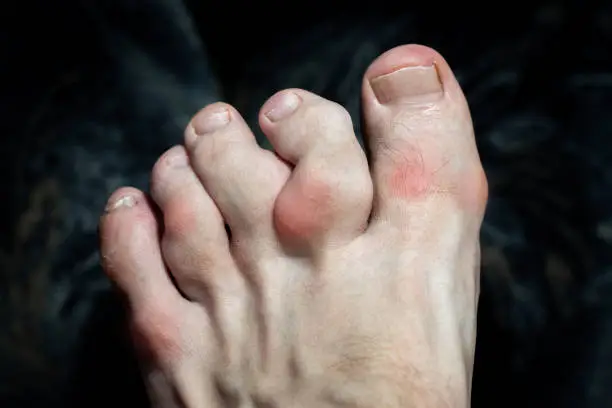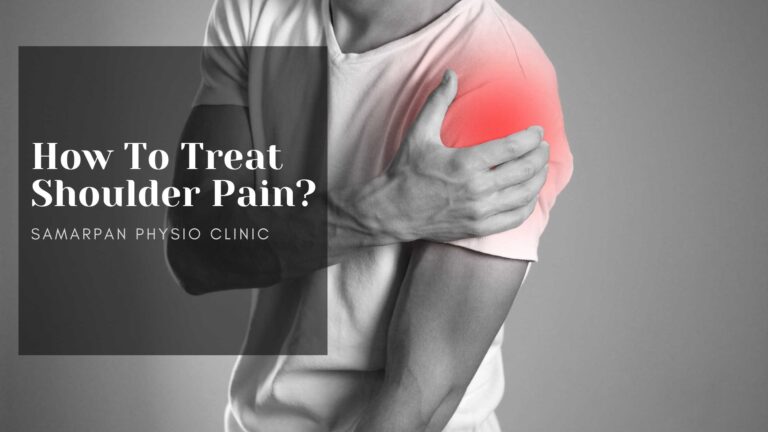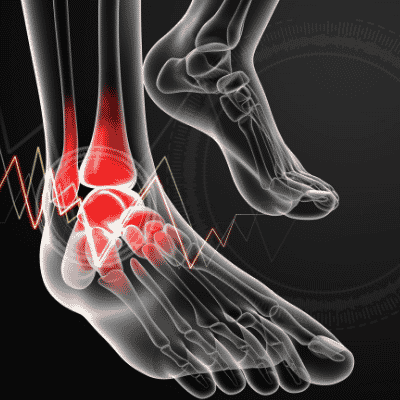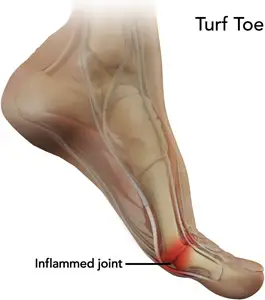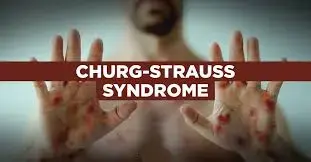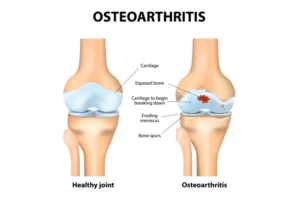Arthritis in Toes
What is Arthritis in the Toes?
When you think of arthritis, you would possibly think of creaky knees, stiff hips, or painful, swollen fingers. Yes, arthritis commonly attacks joints within the hands, knees, and hips. But it can happen anywhere you’ve got joints — including the toes. So, if you can’t bend your great toe or have swelling around your toes, this toe pain could also be caused by arthritis too.
Toe arthritis is often caused by wear and tear of the cartilage in your toe joints, also as inflammation of the toe joints. Arthritis most frequently attacks the big toe, but the opposite toes may be affected, too.
Symptoms
- Pain
- Pain is presumably the first noticeable symptom of arthritis. you’ll feel a general ache in the toes or only the big toe.
- People describe it as starting from a deep, achy feeling to a sharper, stabbing sensation once they try to move. it’s going to be minor, moderate, or severe it depending on the level of deterioration or inflammation in the joint.
- Ache is one of the most common and debilitating symptoms of arthritis. It can stop you from enjoying your normal daily routines.
2. Stiffness
- Over time, arthritis wears away at the cartilage between junctions, inflames tissues, and damages synovia and as a result, the joint becomes stiff and difficult to maneuver.
- With less cushioning and support, joints become immune to bending and stretching. this will result in difficulty walking because the toes play a big part in balance and push the foot off the bottom.
- It may harmful when you try to walk because the toe joint moves with every step.
3. Swelling
- All types of arthritis cause inflammation in the joint, which may result in visible swelling. The toes may turn red and feel consider the touch.
- You may feel this symptom after you have been sitting for a while, or after you get out of bed.
- Swelling also can make it difficult to wear your shoes in the morning. they’ll sense tight until you walk around for a while and the swelling goes down.
4. Clicking and popping noises
- Do you know how it sounds when you crack your fingers? You may start to hear the same sounds in your toes if you have arthritis. A grinding noise may be a fairly common symptom also.
- These sounds are caused by the deterioration of the cartilage that typically cushions the 2 bones in a joint. As that cartilage wears down, the bones may rub against each other, causing these sounds.
- If bone spurs develop, they will also cause clicks and cracks.
5. Change in appearance
- Does your toe appear bigger than it used to? Is it beginning to twist away from your foot? These circumstances can be symptoms of toe arthritis.
- As the cartilage wears down and the bone grinds opposite to the bone, the body attempts to form the situation better. Its solution is to make more bone.
- Although this might stabilize the joint, it also can make it appear larger, or prefer it has a big bump on it, not unlike the looks of bunions.
- It may send the toe off in a new direction, creating a curve or what is sometimes called “claw feet.”
6. Heat
- When inflammation brings more blood to your toes, you’ll feel a sense of warmth or heat in the area. It is often mildly irritating, but it always doesn’t interfere together with your daily activities.
- You may also see redness on the skin around the junction, and they may become tender to the touch.
7. Locked joint
- A locked joint can happen when there’s so much swelling and stiffness that the joint is no longer able to bend at all.
- Rough edges on the bones and bone spurs also can cause a joint to lock up. it’s going to feel like the toe is stuck, and it is often painful.
- This is usually not a permanent condition. you’ll have to walk around for a while or try to manipulate the toe to bend again.
8. Difficulty walking
- All of those symptoms can make walking extremely painful and challenging. you’ll find yourself adjusting your gait as you try to put less weight on your toes.
- You might even choose to stop exercising. Unfortunately, these sorts of changes can affect the rest of your body, causing hip or back pain, weight gain, and other problems.
- Those with arthritis within the big toe are particularly susceptible to immobility.
- Check with your doctor right away if you are feeling any of the symptoms of toe arthritis. There are treatments, orthotics, physiotherapy, and special shoes which will all help you feel better and stay active.
Other symptoms which will occur in people with arthritis in the toes include:
- muscle aches
- anemia
- fever
- curling of the toes, like claw toe or hammer toe
- thick, pitted, or separated toenails
Ache elsewhere in the foot
Risk Factors
The common risk factors associated with the disorder are:
- History within the family of arthritis.
- Wearing poorly fitting shoes or high-heeled shoes for extended periods.
- Carrying excessive weight.
- Growing older.
Types of Arthritis that Affect the Toes
If you’ve got arthritis in your toes, it’s important to know the type of arthritis that might be causing it, because each sort of arthritis has specific medications and coverings. Here are a number of the more common types of arthritis that strike in toes.
Osteoarthritis
- Osteoarthritis (OA) may be a degenerative joint disease where the cartilage that cushions the ends of a joint wears away gradually.
- Osteoarthritis often occurs due to typical wear and tear on a joint that happens with age; it can also occur as a result of injury to the joint.
- OA most ordinarily occurs within the joint at the bottom of the big toe, which is named the metatarsophalangeal or MTP joint.
Rheumatoid arthritis
- Rheumatoid arthritis (RA) is a chronic inflammatory disease in which the body’s immune system attacks itself, causing inflammation and pain within the joints.
- RA can affect several small joints within the foot at the same time, including those within the toes.
- RA often occurs within the small joints of the hands and feet first, though it can affect other joints, like the knees, elbows, hips, and neck.
- Around 90 percent of individuals with RA will have foot problems.
Gout
- For many people, pain and swelling within the big toe, especially at the joint where the toe meets with the foot, is the first symptom of gout.
- Gout may be a type of arthritis that occurs because increased levels of uric acid in the blood accumulate in and aggravate joints, causing inflammation.
- Gout attacks can affect other joints apart from the big toe, including the ankles, feet, knees, or elbows.
- Lumps of acid, called gout tophi, may appear underneath the skin around the toes, ankles, and other joints after you’ve had gout for years or if you’ve got severe gout that is not well controlled.
Psoriatic arthritis
- Psoriatic arthritis is inflammatory arthritis connected to psoriasis, an autoimmune disease of the skin that causes red, silver, scaly rashes on the skin.
- It’s characterized by pain, stiffness, and swelling within the joints.
- People with rheumatoid arthritis might notice pain, stiffness, and swelling within the “knuckles” of the toes.
- People with PsA are likely to possess problems with their toenails, like pitting and crumbling, also as swollen fingers and toes, a condition called dactylitis that creates them appear sausage-like.
- Enthesitis or inflammation at the sites where tendons and ligaments connect to bones are additionally common in PsA. this will show the effect on the Achilles tendon at the heel or cause plantar fasciitis along with the bottom of the foot.
Infectious Arthritis
- Also called septic arthritis, this sort of arthritis typically causes extreme pain and difficulty using the affected joint.
- Septic arthritis is caused by bacteria or fungi that are reached through the bloodstream from different areas of the body, usually settling in one joint.
- A bacterial infection from harm or opening from surgery can also cause infectious arthritis by reaching germs directly to the joint.
- Pain increases with toe movement which will also increase other symptoms like swelling of the toe with difficulty in walking.
- it’s going to include a swollen, red, and warm joint amid fever, chills, fatigue/weakness, and therefore the inability to move the affected joint.
Diagnosis
If you experience symptoms of toe arthritis, you’ll see your regular healthcare provider, although an orthopedic specialist could also be able to diagnose you most expediently. The diagnostic process will likely involve:
- A medical record
- A physical examination of your foot
- X-rays to watch the bony structures of your toes, evaluate cartilage loss, and visualize bone deformities. It’s possible you will have X-rays taken while you’re standing so as to highlight how body weight affects the structures in your foot.
- Although seldom necessary, in some cases advanced imaging like computed tomography (CT scans) or magnetic resonance imaging (MRI) may be used.
- Blood tests surely proteins, antibodies, or acids that might suggest rheumatoid arthritis or gout are performed.
- Joint aspiration, during which fluid in a joint is obtained to examine for infection or uric acid crystals. The results can show other medical conditions or other sorts of arthritis.
Treatment of Arthritis in Toes
Medical Treatment
Non-Steroidal Anti-Inflammatory Drugs (NSAIDs)
Over-the-counter medications like ibuprofen (Advil) and naproxen (Aleve), also as prescription NSAIDs, can help relieve pain and swelling within the joints. However, although many NSAIDs are available over the counter, they will have side effects (such as causing stomach ulcers, increased heart attack risk, and kidney problems), especially when taken in the future and/or in high doses. NSAIDs are a primary line of treatment in OA to reduce pain and stiffness. In inflammatory arthritis and gout, they will be used along with other kinds of medication to treat inflammation, pain, and swelling.
Steroid injections
This medication can help treat and relieve inflammation. An occasional shot is often given in any toe and offers temporary pain relief and reduced inflammation. Injections shouldn’t be done continuously; frequent injections can harmful to the cartilage.
Disease-Modifying Antirheumatic Drugs (DMARDs)
If you’ve got inflammatory arthritis like rheumatoid arthritis, disease-modifying anti-rheumatic drugs (DMARDs) like methotrexate are used as a first-line therapy to assist reduce the immune system activity that triggers inflammation and pain. DMARDs aren’t used for osteoarthritis.
Biologics
Biologics are a more modern class of DMARDs that target specific immune system pathways to reduce immune system activity that is causing inflammation and pain. They’re wont to treat inflammatory types of arthritis, like rheumatoid arthritis and psoriatic arthritis, and are typically offered after patients haven’t skilled conventional DMARDs like methotrexate.
Physiotherapy Treatment
Precautions to stay in Mind Before Exercising
If you’re new to exercise, it’s always smart to first ask your doctor to make sure the exercises are safe and appropriate for you, without exacerbating inflammation or aggravating joint pain. Likewise, if you’ve had surgery on your foot or ankle, get advice from your doctor or podiatrist on what exercises are safe for you.
More tips to help protect your joints:
- Start slowly. Involves your joints in exercise if you haven’t been active for ages. Push too hard or too fast, and you’ll hurt yourself or worsen joint pain. Go easy initially, then increase the length and intensity of your workout as you progress.
- Move gently. At the starting period of every exercise motion, go with slow gentle stretches or a ball massage (by rolling the golf or ball under the arch of your foot) to assist warm up ligaments and getting joints moving through a range of motion. Don’t force any stretches of the muscle and do your movements slowly and easily. Stop if your foot (or anything else) hurts. Take an opportunity when your joints start to ache. If you are sensing any new joint ache or pain that is sharp, stabbing, or constant, it’s time to prevent it.
- Ice after exercise. Cold constricts blood vessels, decreasing blood flow to the joint to assist reduce swelling and inflammation. Just make certain to use a towel or other barriers between the ice pack and your skin to stop irritation. Or try these types of ice therapy.
- Achilles tendon and plantar fascia stretch
Loop a handkerchief around the ball of your foot and pull your toes towards your body, keeping your knee straight. Hold for 30 seconds. Repeat 3 times on each foot.
2. Plantar fascia stretch
Sit down, take a rest, and put the arch of your foot on a round object, like a tin of beans. Roll your foot on the tin altogether directions for a few minutes. Repeat this exercise is done twice each day.
3. Sitting plantar fascia stretch
Sit down and cross one foot over another knee. Grab the bottom of your toes and pull them back towards your body, until you are feeling a comfortable stretch.
Hold for 15-20 seconds. Repeat this 3 times.
4. Calf Stretch
Stand facing a wall, together with your hands flat against it.
Keeping your heels flat on the ground and back straight, slowly lean into the wall—as though you’re doing a pushup against the wall. You can start standing very near the wall; then gradually move a little further away to get a better stretch.
Hold for some seconds; then relax and repeat.
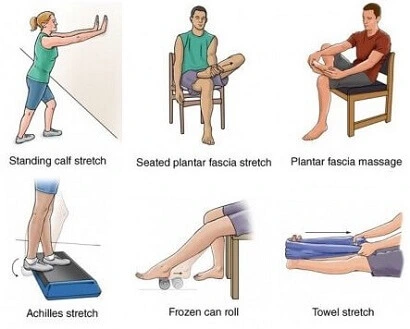
5. Toe Salutes
Resting flat feet on the ground in a sitting position.
Lift your great toe, while keeping the opposite four toes on the floor. Hold for some seconds; then relax and repeat.
Lift your four toes together, while keeping the large toe on the floor. Hold for some seconds; then relax and repeat.
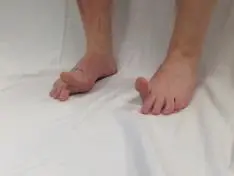
6. Toe Splaying
Resting flat feet on the ground in a sitting position.
Spread all of your toes apart as far as comfortable. Hold for some seconds; then relax and repeat.
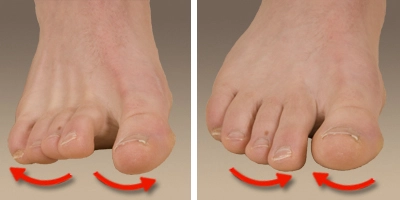
7. Toe Squeezing
Place foam toe dividers between your toes (such as pedicure toe dividers).
Squeeze your toes together for some seconds; then relax and repeat.
8. Ankle Alphabet
Sit down in order that your feet don’t touch the floor.
Use your foot to write down each letter of the alphabet in the air, leading together with your big toe. Keep the motions small, foot and ankle only use.

9. Towel Curls
Resting flat feet on the ground in a sitting position.
Place a little towel on the ground in front of you.
Grab the middle of the towel with your toes and scrunch your toes, curling the towel toward you. Relax, then repeat.
10. Towel pickup
Sit down with a towel on the ground in front of you. Keeping your heel on the bottom, devour the towel by scrunching it between your toes. Repeat 10 to twenty times. As you improve, add a little weight, like a tin of beans, to the towel.

11. Toe Extension
Sit on a chair, together with your feet resting on the floor.
Pick one foot and place it on the opposite thigh. Hold on to your foot with one hand.
Grab your toes with the opposite hand and bend them toward your ankle and hold for a few seconds; then back toward your heel and hold for a few seconds. Keep your movement gentle and smooth.
Repeat.
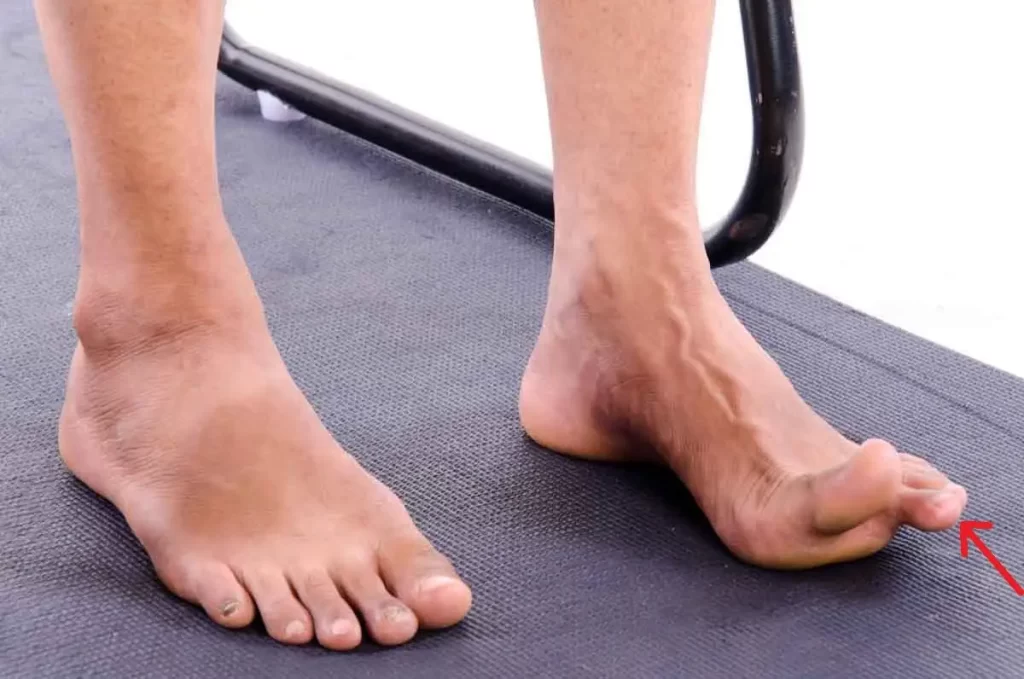
12. Standing heel raise
Using a counter or chair for support, get up on your tiptoes, together with your knees straight. Slowly lower your feet and backtrack. Repeat this 10 times.
13. Ankle out
Make a loop out of a bit of an elastic fitness band, and hold it in situ, either with the leg of a table or chair or together with your other foot. Place one foot in the loop. Keeping your heel fixed on the bottom, turn your toes outwards against the resistance of the band. Bring your foot back to the first position slowly. Increasing the repetition up to tolerance and repeating this 10 times, and doing the set 3 times a day.
14. Basic balance
Using a static object such as a kitchen edge for support, balance on one foot. Build up how long you are doing this for, aiming for one minute. Try to do this 3 times, and repeat the set twice each day.
Take any opportunities to practice standing on one leg – building it into your daily activities will facilitate your improvement.
When you feel confident with this basic balance exercise, you’ll make it harder by standing on a cushion or pillow. Build up the quantity you do slowly.
When you can easily balance on a pillow, and if you’re feeling confident, return to standing on the floor and repeat the basic balance exercise with your eyes closed.
15. Walking within the sand
This is best for strengthening your toes, feet, and calves. It is often tiring, so roll in the hay for 5 to 10 minutes at first, then increase the time as tolerated.
Walk barefoot in a place covered with sand, like a beach or sandbox.
16. Cold compress
Cold therapy can help to alleviate inflamed heel tissue. One option is to use a cloth-covered ice pack for your heel. you’ll also apply a cold compression pack to assist keep the ice pack in place. These are bought at many drugstores as gel packs or cold foot wraps. they’re kept in the freezer and then wrapped around the foot and ankle. Leave the wrap only for ten minutes at a time, then take it out. Repetition of the cold wrap application on an hourly basis while you’re awake. A different option is to roll your foot over a cold or frozen water bottle.
17. Shoes and orthotics
Comfortable and well-fitting shoes can reduce the quantity of pressure on the heel spur. This pressure can cause pain and discomfort. Here’s what to look for when choosing a shoe for comfort:
- Firm heel support: the rear “counter” of the shoe should be firm in order to assist the heel and stop your foot from rolling inward or outward.
- Moderate flexibility: A shoe shouldn’t be very easy to flex because it’s collapsible. However, the shoe should have a gradual bend that has some hardening when your foot is flexed or bent.
- Slightly elevated heel: A heel insert or shoe that features a slightly elevated heel (no more than 1 inch high) can help take pressure off your painful heel. You can also have custom orthotics (molded shoe inserts) made that will be put into your shoe. These orthotics are custom-designed to stop your foot from rolling and supply extra heel support. they’re made with a prescription from your podiatrist.
18. Cryoultrasound
Cryoultrasound therapy combines the appliance of electromagnetic energy and cold therapy to decrease aches. The machine seems like a large wand that is moved over the foot and ankle. Research has found that Cryoultrasound therapy is an efficient treatment solution trusted Source for people with plantar fasciitis who even have heel spurs. Podiatrists and physical therapists often give this therapy.
Surgical Treatment
There are three main sorts of surgery that could be used to help a person with arthritis in the toes. These are:
Cheilectomy
A cheilectomy is most ordinarily used when damage to the toe is mild or moderate. An incision is formed, and parts of the bone are removed in order that the toe can move more freely.
The toe may remain swollen for several months, but most people experience long-term relief.
Improvement is permanent in around 75 percent of individuals. In some cases, a person’s arthritis may still worsen, and another operation may be required.
Arthrodesis
Arthrodesis is when the bones are fused together during a permanent position, using pins, screws, or a plate.
The toe won’t move again, but arthrodesis is the most reliable way of treating severe pain, with a hit rate of around 95 percent.
Arthroplasty
In arthroplasty, the joint surfaces are removed and replaced with a man-made joint. This procedure is more common for older people that may not need to be as physically active as someone younger.
Home Remedies for Arthritis in Toes
You can do some things to help remedy your toe arthritis.
Modify your footwear
- You want to wear shoes that take the pressure off your toe joints to decrease some of the stress from arthritis of the toes.
- Search for footwear with a more rigid, stiff sole (which will provide support) and a good toe box to help prevent excessive stress and bending forces on the toe joints.
- Ditch high heels; they put your foot in the upright position which takes a toll over time.
- Soothe with ice and warmth Cold therapy can provide relief for inflamed joints within the wrist.
- Cold constricts the blood vessels within the muscles, which decreases blood flow to the joint area to assist reduce swelling and inflammation.
- Heat therapy warms the skin and therefore the junctions, which causes blood vessels to dilate, and sends more oxygen (o2)and nutrients to the joints and muscles. Try both and see which causes you to feel best.
Exercise to take care of a healthy weight
- Control your weight with regular, low-impact aerobics that doesn’t hurt your toes.
- Cycling on a recumbent bike or swimming may be a good option.
- Keeping your weight near your confirm body mass index (BMI) is one of the best things you can do to control your toe ache.
- Being at a healthy weight balances the pathomechanics [the mechanics of damaged bones, and tendons] of the whole foot and decreases stress on the toes.
- It’s also a good idea to try particular exercises that strengthen your Achilles tendon (the cord at the back of your heel) as well as the tendons in the balls of your feet and toes. you’ll even simply wiggle your toes.
Eat a clean diet
- Maintaining a healthy weight assists to decrease stress on the joints. Feet are a weight-bearing joint, so obesity makes arthritis serious.
- Losing excess pounds can cause less pain and better function.
- You especially want to eat healthfully since your exercise abilities could also be limited if you have a lot of pain in your toes.
- Aim to eat foods that will help reduce inflammation, called anti-inflammatory foods.
FAQ
What triggers arthritis in the toes?
Toe arthritis is caused by inflammation of the toe junction. The disease most frequently attacks the big toe, but the others could also be affected as well. Past
harms or traumas, like a crack or sprained toe, can cause arthritis down the road. Osteoarthritis, atrophic arthritis, and gout can also be to blame.
What is the best thing for arthritis in your toes?
Image result for frequently asked questions for arthritis in toes NSAIDs is the first line of treatment in OA to scale back pain and stiffness. In inflammatory arthritis and gout, they will be used along with other kinds of medication to treat inflammation, pain, and swelling. A topical gel like diclofenac (Voltaren) could also be prescribed for toe arthritis.
Can you reverse arthritis in your toes?
You can’t reverse your arthritis, but certain treatments can help slow the progression of the disease and facilitate the manage your condition. Getting the
right kind of treatment can ease your pain and help you maintain or even improve function, which can enable you to carry out daily activities.
What does arthritis in the toes feel like?
Inflammation: all types of arthritis can cause aggravation in the joint, which may result in prominent swelling. The toes can turn red and sense warm when
touched. Popping and Clicking Noises: As the cartilage deteriorates, the bones can begin rubbing against each other, causing these sounds.
What does pain in the toes indicate?
Some common causes of the toe ache include arthritis, calluses, bunions, and nail conditions. Toe aches can come on suddenly and severely, or it’s going to
develop gradually over time. it’s going to last briefly or be constant. Symptoms can include burning, prickling, or pins-and-needles sensations.

